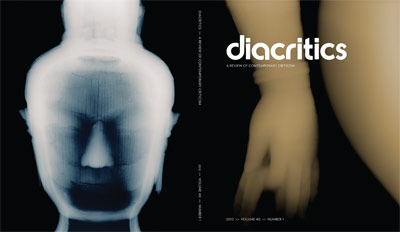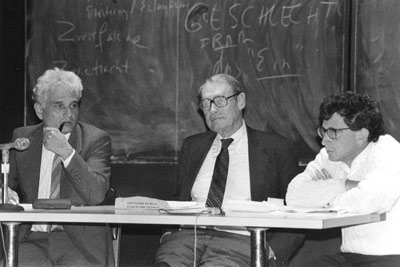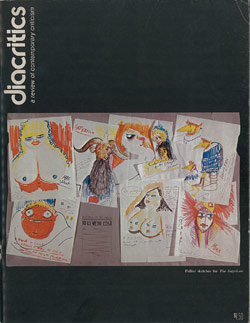Diacritics at 40: Redesigned literary journal archives its past
By Daniel Aloi


Diacritics, a journal of criticism and theory, is celebrating its 40th year of publication with a complete redesign in print and online, and the donation of its archives to Cornell University Library. Vol. 40, No. 1, to be published in October, honors the past by reviving the original cover title design from 1971-72.
Subtitled "A Review of Contemporary Criticism," diacritics was founded by then-Romance studies chair David Grossvogel, who served as editor until 1976. The journal debuted in fall 1971, announcing itself as "a forum for discussion of critical approaches to literature and experiments in literary creation." It featured an eclectic mix of criticism, works in progress and articles ranging from film theory to semiotics.
Diacritics soon established its reputation as one of the leading journals in literary theory and continental philosophy. Philosopher Jacques Derrida came to Cornell as an A.D. White Professor-at-Large, 1982-88, due in part to his association with the journal.
"Diacritics played a major role in the international recognition of French thought in the 1970s and '80s," said Laurent Dubreuil, general editor of diacritics since 2011. "Almost all the prominent scholars in our fields writing in English, Italian or French have been published by us at some point of their career."
The first issue included an interview with Claude Lévi-Strauss and a "Polemic" by Michel Foucault against literary critic George Steiner that led to a heated exchange between them in the winter 1972 issue, according to professor of comparative literature Jonathan Culler (managing editor 1982-84, co-editor 1993-96).
Such intellectual exchanges -- along with bold color covers and illustrations throughout -- made diacritics unusual for its time.
"Initially diacritics distinguished itself from other journals of literary theory by having a long review article that would engage with a work of criticism, and often take issue with it and elicit a response," Managing Editor Diane Brown said. "We are hoping to make such review articles prominent again."
In the next issue, David Kazanjian reviews former Cornell professor Susan Buck-Morss' book "Hegel, Haiti, and Universal History," with an exchange of responses between Buck-Morss and Kazanjian.
The issue also features a previously unpublished essay by deconstructionist Paul de Man, who taught at Cornell in the 1960s. English professor Cynthia Chase, a de Man scholar, assisted the piece's co-editors, Amalia Herrmann, M.A. '02, and John Namjun Kim, M.A. '00, Ph.D. '04, in preparing de Man's original typescript for a scholarly edition.
The name "diacritics" was proposed by Romance studies professor emeritus Philip Lewis, who served as associate, managing and general editor between 1971 and 1987 and later became dean of the College of Arts and Sciences.

"The name calls attention in a specific way to what it means -- to supplement language and discuss literature as a product of language," Brown said.
Dubreuil has designed three new series of thematically linked issues of the journal that explore radical politics and its limits, humanities intersecting with the sciences and theorizing the aftermath of globalization.
"A journal like ours is the perfect place for thinkers to be bold again," Dubreuil said. "Our history is already associated with the wide renovation of scholarship in the '70s, and we reach tens of thousands of readers every year."
Diacritics retains a strong visual component, Brown said. In recent years the journal has highlighted a single artist per issue. The new issue features photographs by David Maisel of X-rays of art objects, hinting at the journal's archival efforts.
The diacritics collection in the Cornell Library's Division of Rare and Manuscript Collections (RMC) will include new interviews with early editors, including Lewis, Culler and Richard Klein, conducted by Brown and RMC curator Laurent Ferri.
Media Contact
Get Cornell news delivered right to your inbox.
Subscribe